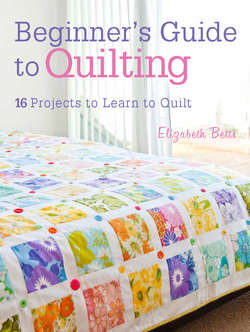Читать книгу Beginner's Guide to Quilting - Elizabeth Betts - Страница 5
На сайте Литреса книга снята с продажи.
ОглавлениеTools and Equipment
It can be appealing to buy lots of haberdashery when you start making patchwork. I suggest you begin with a hand sewing kit, then buy other sewing tools as and when you need them. A good basic hand sewing kit should contain needles, thread, scissors, thimble, pins, tape measure and seam ripper. Keep your sewing kit in a box. There are some pretty ones available to buy, although a toolbox from a DIY store does the job just as well! It is also worth having a notebook and pencil handy when sewing to jot down notes and ideas as you stitch.
Basic kit
Needles: Use Sharps for hand piecing, and embroidery or chenille needles for hand quilting with perle thread. Buy a pack of needles with different sizes so you can try them to see which one you feel most comfortable using.
Thread: Make sure you buy a good brand from a sewing shop as it will be colour-fast and you will be less likely to have tension issues with your sewing machine. For piecing cotton fabric it is best to use 50-weight 100 per cent cotton thread. Natural colours, such as light grey or beige, tend to tone with most fabrics, so buy them on large reels to save money and trips to the shop to buy more thread when you run out. For big stitch hand quilting, I use perle thread in a size 8. For machine quilting, look for threads specially made for this purpose as they will be stronger.
Scissors: It is handy to have at least two pairs: a large pair for cutting fabric, and a small pair for snipping threads. It is also good to keep a pair of paper scissors in your sewing box so you aren’t tempted to use your fabric scissors on template plastic or paper as this will blunt them.
Thimble: These are available in metal, plastic and even leather. Try out different styles and sizes to see what suits you.
Pins: Different types of pins are available, but for patchwork look for long, fine pins. Flower- or glass-headed pins are handy if you work in a space also used by children or pets, as you can spot them easily if you drop them.
Tape measure: A standard tape measure is fine; however, if you plan to make large quilts, look for an extra long (120in/300cm) one.
Seam ripper: This is an essential tool for unpicking seams quickly.
Notebook and pencil: These are handy to keep nearby when sewing to make notes on, for example, colour of thread used, size of stitch, or ideas that come to mind while sewing.
Other quilting tools
Marking tools: These are used to mark sewing or quilting lines on the fabric. The types most widely used are:
Chalk based – pencils, tailor’s chalk, propelling pencils.
Pens – water-soluble or vanishing pens.
Adhesive tape – low-tack masking tape, 1⁄4in (0.6cm) wide.
Pressure based – the Hera marker uses a pressure to mark quilting lines.
Template plastic: This is a sheet of a strong plastic that is used to make patchwork or quilting templates.
Quilter’s safety pins: These are normally curved to make using them easier. They hold the layers of the quilt together ready for quilting.
Rotary cutter: If you are machine piecing, one of these is essential. Rotary cutters come in several sizes, but the 45mm is the one most widely used for patchwork (see Rotary cutting for more information).
Self-healing mat: An A2 size mat is the most useful, as it comfortably fits a piece of 44in (110cm) wide fabric folded in half. I also find an A3 size handy if sewing at home on a small table (see Rotary cutting for more information).
Acrylic ruler: Rulers come in many different shapes and sizes, from small 4in (10.2cm) squares to hexagons and circles (see Rotary cutting for more information).
Sewing machine: There are some lovely sewing machines marketed at quilters; however, all you need to start is a basic sewing machine that sews a straight stitch. If you are trying patchwork for the first time, it may be that you can borrow a sewing machine, which will give you a better idea of what you are looking for when it comes to buying one. For quilt making using a sewing machine, it is handy to buy a 1⁄4in (0.6cm) foot, a darning foot and a walking foot to go with the standard feet that come with your machine. More details of these are given in the Machine piecing and Straight stitch machine quilting sections.
You can get useful advice from specialist sewing machine shops, which will usually let you try one out. Some features, such as needle up/down, speed control and the ability to machine sew a blanket stitch, are handy to have, but these are not essential.
